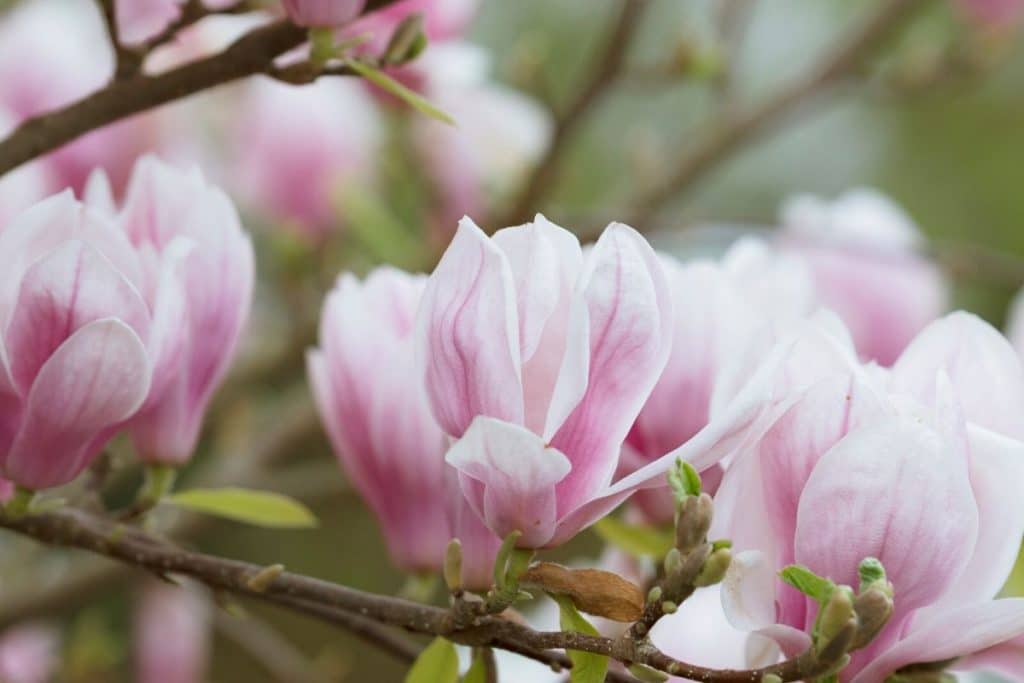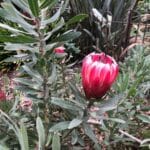Magnolias come from the Magnoliaceae family, and, even though they are native to Eastern and Southern Asia, more specifically to China, they can also be found in the Americas.
What’s more, magnolias are an ancient type of flower, and it has been argued that they first appeared many thousands of years ago.
One important characteristic this species has is that they are survivors, this means that they can and will grow and thrive even in the most difficult conditions.
There are many magnolia species, in fact, there are more than 200 species, but the one thing they all have in common is that each one of them has very distinctive yet beautiful blooms.
Most Magnolias are also known for having a sweet fragrance that could last for days. Continue reading this article about magnolias and you’ll soon become an expert!
- Magnolia Flower Facts
- Magnolia: General Description, History, and Name
- Common Types of Magnolia Flowers
- Anise Magnolia (Magnolia salicifolia)
- Jane Platt (Magnolia stellata)
- Bigleaf Magnolia (Magnolia macrophylla)
- Loebner Magnolia (Magnolia x loebneri)
- Ashes Magnolia (Magnolia ashei)
- Kobus Magnolia (Magnolia kubos)
- Star Magnolia (Magnolia stellata)
- Cucumber Tree (Magnolia acuminata)
- Saucer Magnolia (Magnolia x soulangiana)
- Lily Magnolia (Magnolia liliflora)
- Southern Magnolia (Magnolia grandiflora)
- Sweet bay Magnolia (Magnolia virginiana)
- Champak Magnolia (Magnolia champaca)
- Umbrella Magnolia (Magnolia tripetala)
- Alba Superba (Magnolia x soulangeana)
- Forrest’s Pink (Magnolia denudata)
- Butterflies Magnolia
- Merrill Magnolia (Magnolia x loebneri)
- Yellow Bird Magnolia (Magnolia x brooklynensis)
- Leonard Messel (Magnolia x loebneri)
- Hot Flash Magnolia
- Copeland Court Magnolia (Magnolia sprengeri var. diva)
- Black Tulip Magnolia
- Galaxy Magnolia
- Centennial Magnolia
- Ivory Chalice Magnolia
- Daybreak Magnolia
- Diva Magnolia (Magnolia sprengeri var. diva)
- Star Wars Magnolia
- Differences between Magnolia Trees and Magnolia Shrubs
- Growing Magnolias: Everything You Need To Know About It
- Benefits and Uses of Magnolias
- Common Question About Magnolias
Magnolia Flower Facts
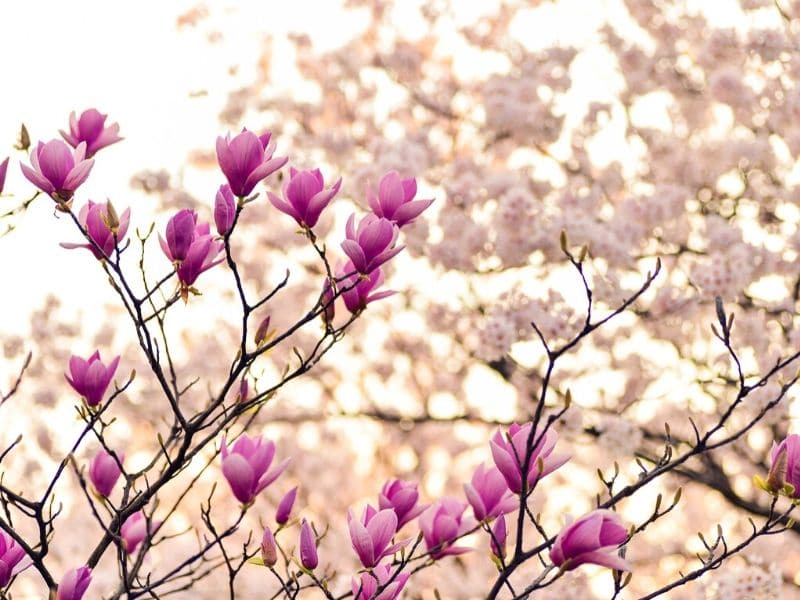
Magnolia trees usually have very large flowers that can be seen from a distance. The shape of these flowers can be tulip-like or star-shaped, and they can become huge once they open up.
Another important thing about magnolias is that they don’t have petals or sepals; instead, they have something called ‘’tepals’’, which is a combination of petals and sepals.
Magnolias are truly beautiful. It can be argued that they are a type of flower that everybody recognizes and loves. Magnolias can grow either as trees or shrubs, and its flowers can be pink, red, yellow, white or purple.
A young magnolia tree might take several years to bloom. Certain magnolia types begin blossoming in early spring, and some even in the dead of winter. If they develop buds or flowers at this season, they are likely to experience frost damage, which might result in blackened blooms or buds.
Magnolia: General Description, History, and Name
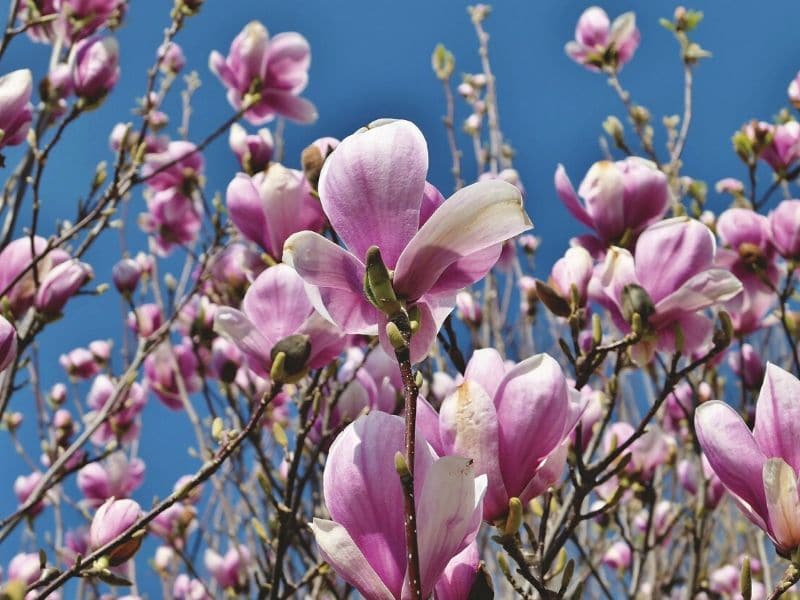
Magnolias can be traced back before bees. In other words, magnolias are one of the oldest types of flowers that have ever existed (1).
The name Magnolia trees is about after a French botanist called Pierre Magnol, decided to transplant a Magnolia tree to Europe, more than 300 years ago.
He was so fascinated with this tree, that it was all he could ever think about. Thus, the flowers had to be named after him.
Also, because healthy trees are so ancient, they are not actually able to produce any nectar, because when they first appeared bees didn’t even exist. Instead, they produce pollen and rely on beetles for pollination, making Magnolias a very interesting and unique exception in nature.
Common Types of Magnolia Flowers
Anise Magnolia (Magnolia salicifolia)
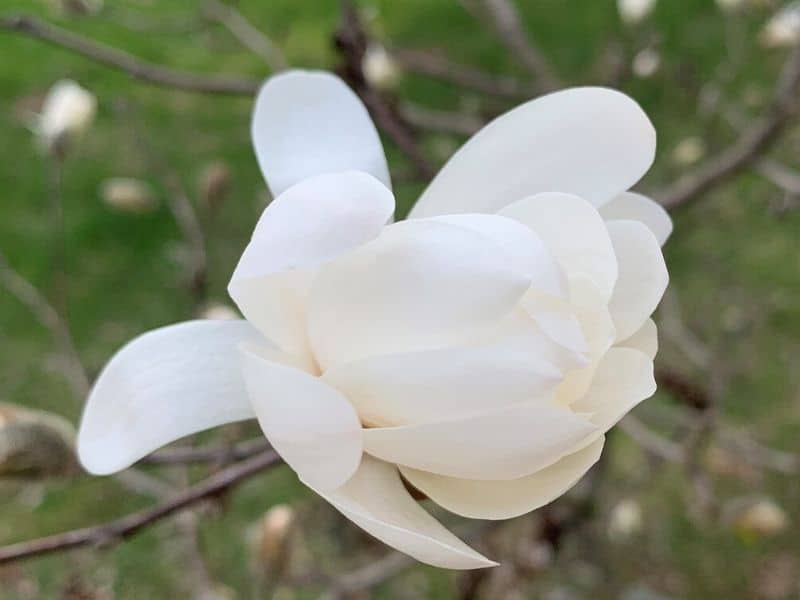
The fragrant white blooms are 8 inches across and arrive in late spring and on and off throughout the summer. Their leaves are very wide in comparison to other Magnolias.
Jane Platt (Magnolia stellata)
This type is a hybrid magnolia and they are usually small trees. They also have pale pink petals, however, they don’t have any leaves in their branches.
Jane Platt trees can grow up to fifteen feet in height and can be found in China and Japan. They don’t feel comfortable with lots of water, so cannot survive in areas where floodings occur.
Bigleaf Magnolia (Magnolia macrophylla)
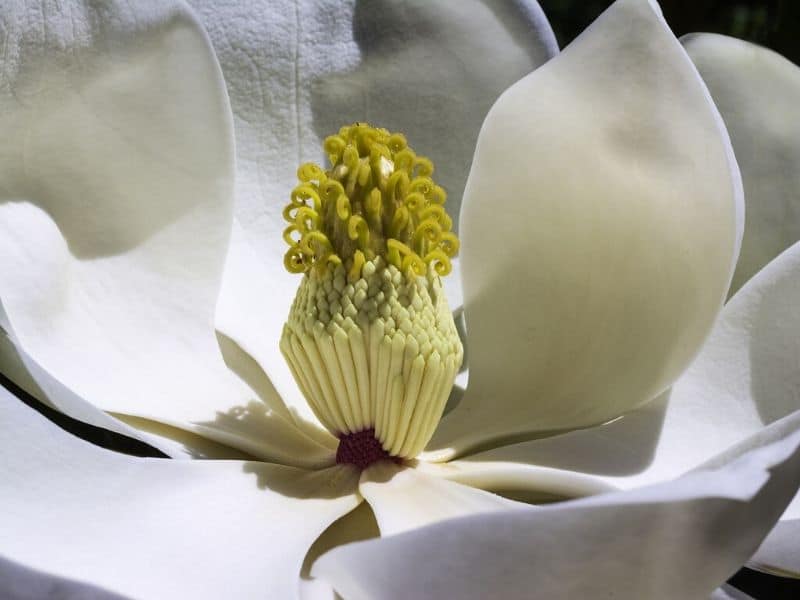
This Magnolia stays true to its name, as it can produce massive leaves. It can be an evergreen tree in warm areas, although it is often a deciduous tree. Its blooms can be either white or purple, and sometimes a combination of these two colors.
Loebner Magnolia (Magnolia x loebneri)
Another hybrid Magnolia, it is a combination between the Kobus and Star Magnolias. Small stems can be seen throughout the tree and it is easily recognized because of its fragrance.
It either has pink and white, lilac or blush pink flowers and small oval leaves.
Ashes Magnolia (Magnolia ashei)
They are very similar to Bigleaf Magnolia because it leaves grow really big. It has white flowers and it loves humid climates.
Kobus Magnolia (Magnolia kubos)

Its flowers are white with pink detail and they have dark-green leaves that grow very slowly. They can be found in Japan and Korea, and they can grow up to 50 feet in height.
Star Magnolia (Magnolia stellata)
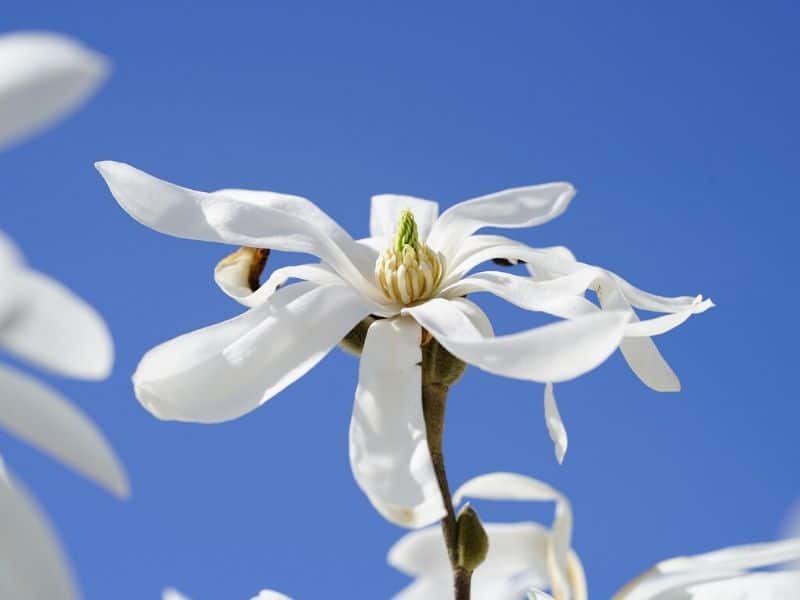
One of the most famous Magnolia species, they love cold weather but it can adapt to many other types of weather. Even though they grow slowly, they can reach up to fifteen feet in height. Star Magnolia’s flowers are usually white and they are very fragrant.
Cucumber Tree (Magnolia acuminata)
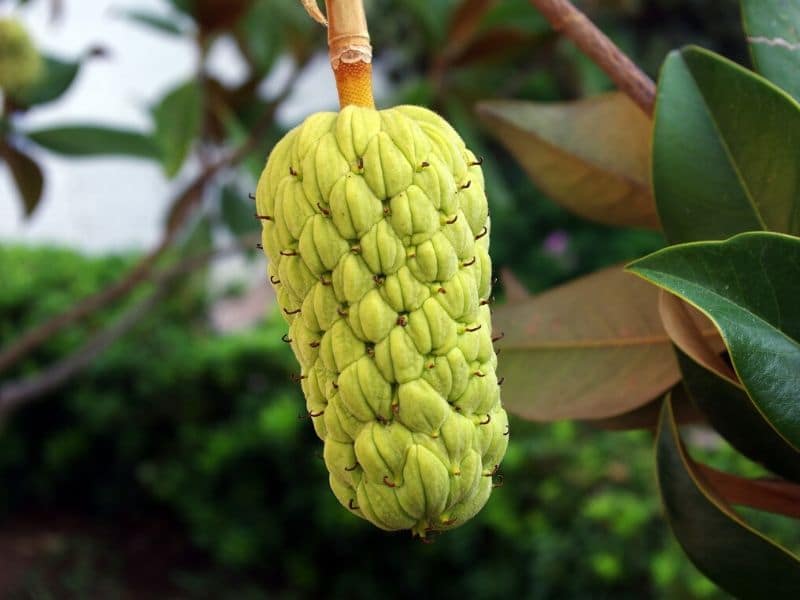
Definitely one of the most famous and recognized Magnolias, prized for their large, fragrant flowers. Some people even confuse them with exotic vegetables! These cold hardy trees thrive in cool climates and can reach impressive heights, making them a majestic addition to any landscape. Native to Eastern North America, they’re particularly well-suited to the Appalachian Mountains.
Saucer Magnolia (Magnolia x soulangiana)

Also known as the pink tree, this type of Magnolias are very small, fragrant and delicate. They have white, purple or pink flowers and they love being exposed to the sun. It is a hybrid Magnolia, and its parents are the Lily Magnolia and the Yulan Magnolia. It can grow up to 25 feet in height (2).
Lily Magnolia (Magnolia liliflora)
One of the smallest Magnolias, they grow as a small tree. Its flowers are red, purple or pink. They can grow up to 12 feet and love the sun.
Southern Magnolia (Magnolia grandiflora)
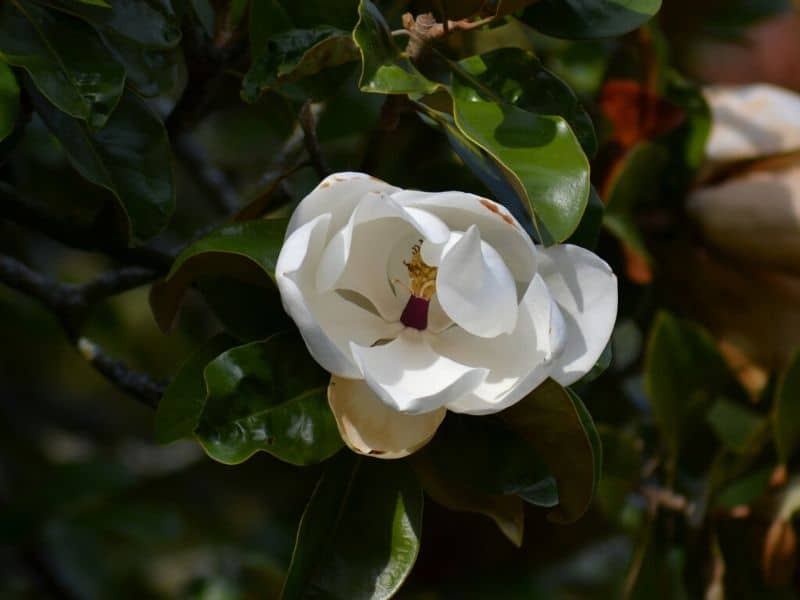
One of the most common types, they love to have all the sun directly towards them. Because of their size, they tend to need a lot of space in order to grow. They have white flowers and love acidic soil (3).
Sweet bay Magnolia (Magnolia virginiana)
It is very adaptable so it can grow in either warmer zones or colder zones. They are native to the U.S and can grow up to 35 feet. They also release a lemony fragrance that is easily recognized, and, because of this, they attract many birds. They can tolerate droughts (4).
Champak Magnolia (Magnolia champaca)
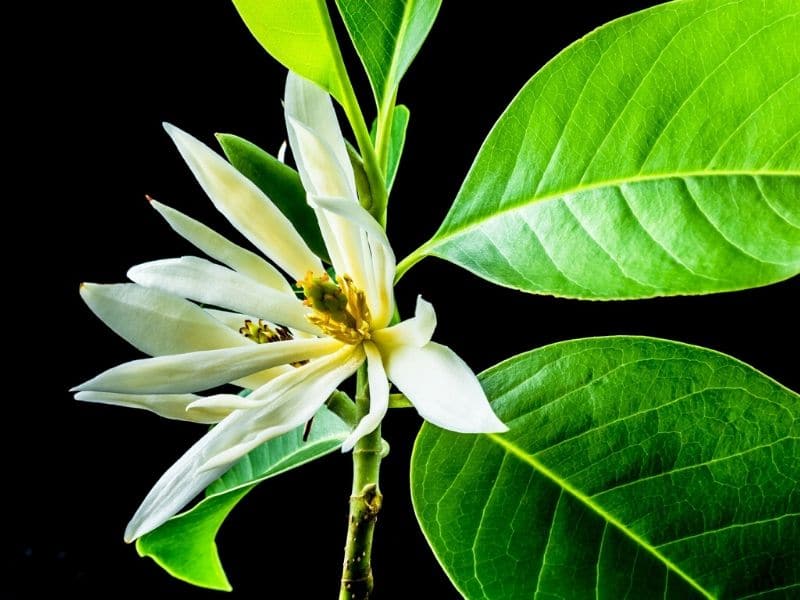
They have white, yellow or orange flowers. They are native of southern Asia, although nowadays they can also be found in many other areas of the world. Also, Champaca Magnolias love humid climates and can grow up to 30 feet.
Umbrella Magnolia (Magnolia tripetala)
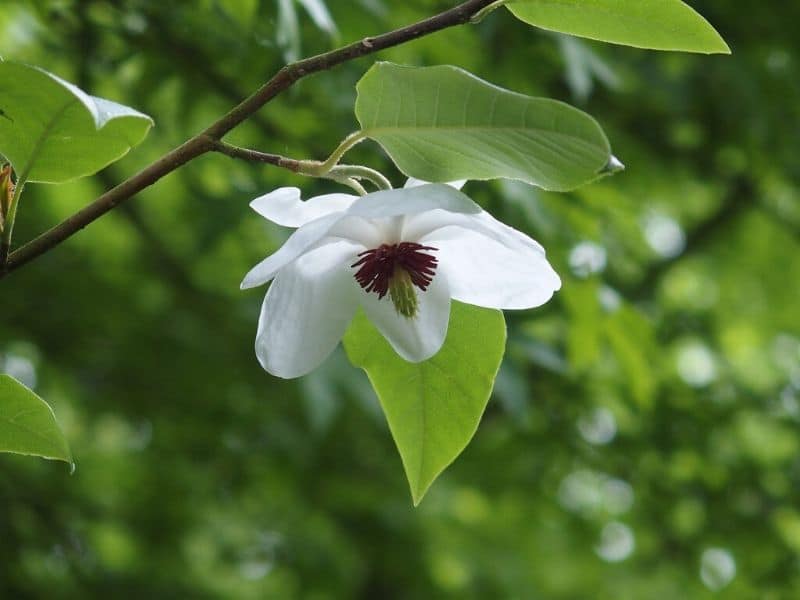
It has giant leaves and its native to the Appalachian Mountains. It usually prefers the shade, and it has creamy white flowers. They often need pruning in order to avoid any diseases.
Alba Superba (Magnolia x soulangeana)
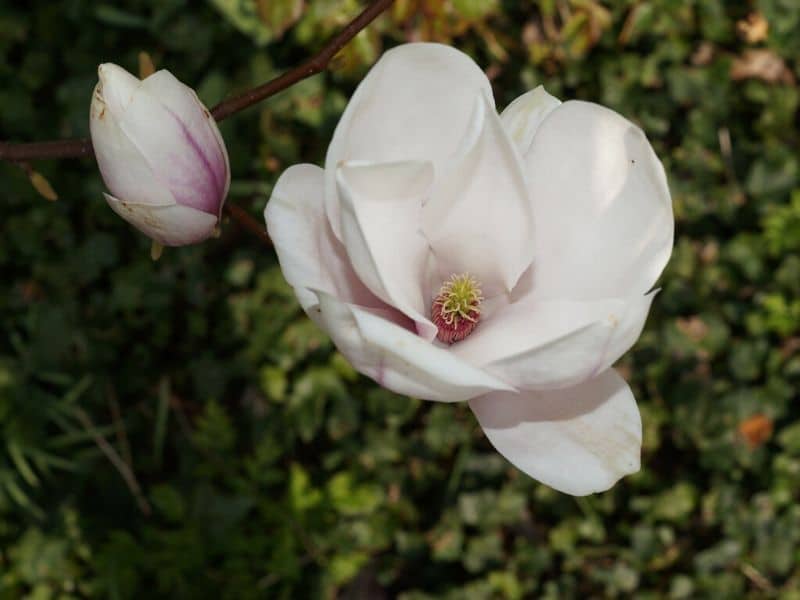
It loves the sun and they are perfect for small places. They have white petals and sometimes have a purple-pink flower. It is very fragrant and it can expand itself very quickly.
Forrest’s Pink (Magnolia denudata)
One of the most beautiful Magnolias, it has colorful petals that have a bubble gum pink tone. They love being exposed to the sun, and they are very similar to some types of lilies.
Butterflies Magnolia

Another hybrid Magnolia, it has sunny yellow flowers. It can be cultivated as a tree or a shrub, depending on the landscape. Because of the way it was created, Butterflies Magnolias can survive in the heat and in the cold.
Merrill Magnolia (Magnolia x loebneri)
Another hybrid Magnolia, it also looks like a star. It can grow up to 30 feet and it has white petals. It usually blooms at an early stage, thus it is highly recommended for those who would like to decorate their gardens and see almost immediate results.
Yellow Bird Magnolia (Magnolia x brooklynensis)
They are really tall and they can grow up to 40 feet tall. They also have a shape similar to a pyramid. Its flowers are yellow. They also have dark-green leaves that have an oval shape.
Leonard Messel (Magnolia x loebneri)
These are small flowers that have deep pink petals. It sometimes has a white stroke inside the petal as well. The best soil is a dry, well-drained, slightly acidic combination of organic materials.
Morover, it can easily grow up to 20 feet high.
Hot Flash Magnolia
A hybrid plant, they have yellow petals that are very similar to tulips. These magnolias thrive in all types of soil and dry weather. They can grow up to 30 feet in height.
Copeland Court Magnolia (Magnolia sprengeri var. diva)
Sometimes referred to as Sprenger’s Magnolia, this flower has pink petals and dark-green leaves. It loves to have direct sun and well-drained soil. It doesn’t like humid weather.
Black Tulip Magnolia
One of the most striking deciduous Magnolias, it looks like a very special tulip. Its color is burgundy and can grow really fast. They can reach up to 20 feet high.
Galaxy Magnolia
It can grow up to 25 feet high, and it has deep purple petals. Sometimes its petals can have up to four different colors and shades.
Centennial Magnolia
They are late bloomers and can grow up to 20 feet tall. They have white petals and love to be in the sun.
Ivory Chalice Magnolia
Another hybrid Magnolia, it has a pyramid shape when it grows. It can easily reach up to 40 feet high, and it loves being exposed to the sun.
Daybreak Magnolia
Even though it’s a small tree, it can still grow up to 40 feet high. It has light pink flowers and it doesn’t thrive in cool weather in late winter.
Diva Magnolia (Magnolia sprengeri var. diva)
It’s one of the largest Magnolia trees and it can reach up to 55 feet high. It has deep rose-pink petals and they require a lot of maintenance.
Star Wars Magnolia
It is a slow growing, wide-spreading little tree or big shrub that can grow to be 15 feet tall or more. It has pink fragrant flowers that can be seen from a distance and green glossy foliage.
Differences between Magnolia Trees and Magnolia Shrubs
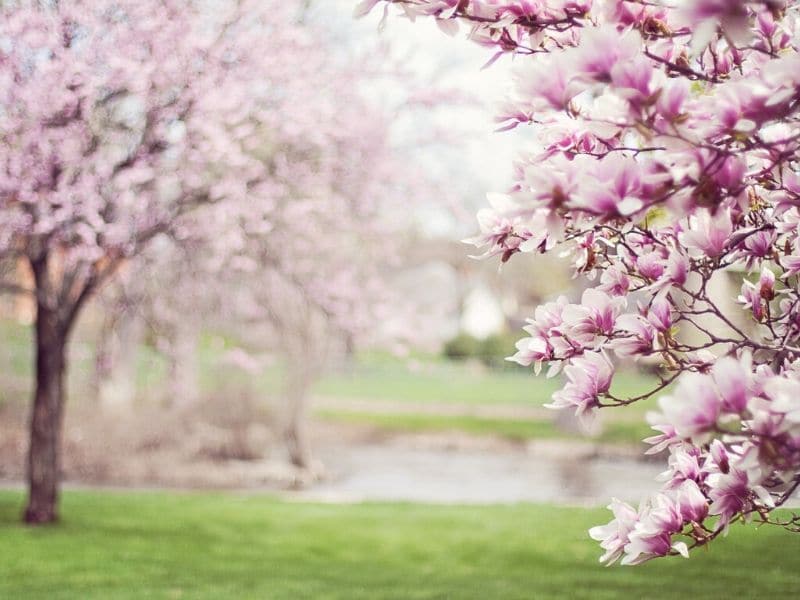
Magnolias are either deciduous or evergreen, and their sizes range from small shrubs to enormous trees. However, the trees tend to produce many stems that can appear at their base, thus they have a fuller base, and, on the other hand, a smaller magnolias shrub only has one or a couple of thinner branches.
Growing Magnolias: Everything You Need To Know About It
Have you ever wondered how to plant Magnolias in your garden? This is your chance then, follow these steps and you will definitely succeed at it!
Magnolias are not difficult to plant, however, you must pay attention to some basic guides. For example, you need to choose your site carefully because Magnolias tend to spread out. Also, most Magnolia trees prefer well-drained soil, filled with organic matter. If you have a prepared compost then do not hesitate to place it on top of it.
In addition, look out for the difference between evergreen species and deciduous species, especially in terms of sun exposure.
Magnolias prefer warmer climates with full sun to light shade locations protected from the hot afternoon sun and strong winds.
How to plant Magnolias?
You will first need to dig a planting hole that will be twice as wide as the roots of your Magnolia. Water well and keep the soil wet for the first few weeks after planting to aid in the establishment of new roots.
You can do this before placing your Magnolia trees or evergreen Magnolias, however, do not overwater them, as they like to have their shallow roots with a little moisture.
You can apply mulch or compost and now you can cover the root ball. You can irrigate two or three times a week, it will all depend on where you live.
Magnolia Care and Maintenance
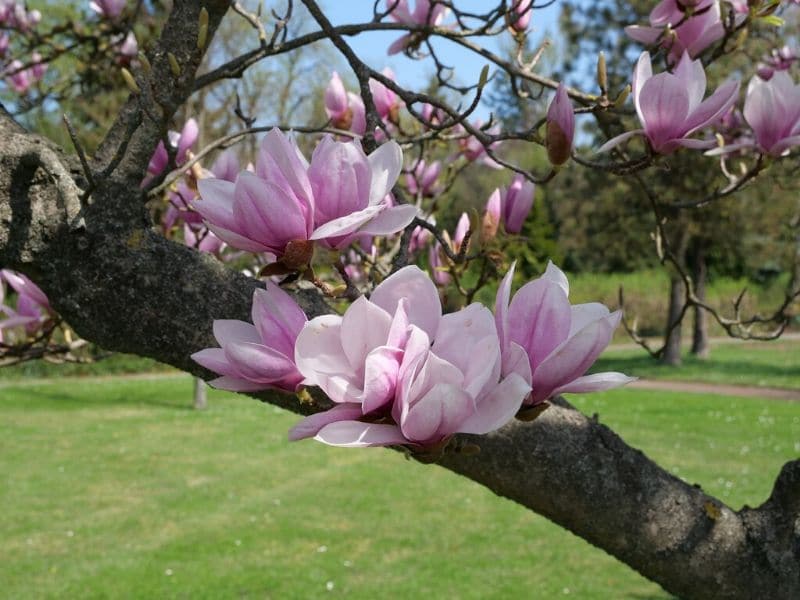
Magnolias prefer slightly acidic soil, so if yours is either neutral or alkaline, then you will have to amend it in order to help your deciduous plant grow. In addition to this, you will have to continue with the amends every now and then.
Don’t be scared by this though, Magnolias are easy to care and they are actually very resistant to different types of weather, diseases, and pests.
Also, once you plant a Magnolia and you see it grow, you can expect it to have it for at least 100 years.
You can prune your Magnolias in the early summer, this will not only make them look good, but it will also help them blossom the following spring.
Magnolia’s Pests and Diseases
Magnolias are very resistant to different fungal diseases and pests. If you see that your Magnolia is not looking good, then the first thing you need to do is check the soil, and, if needed, try to amend it.
Powdery mildew is a common fungal disease that can affect Magnolias, causing glossy leaves to become twisted and warped, turning yellow or brown.

Benefits and Uses of Magnolias
Medicinal uses
It’s amazing how many benefits are associated with Magnolias. From weight loss to constipation (5), to reducing anxiety (6), stress and depression, this type of flower has been used for centuries.
You can use the flower buds if you have a runny nose, a cold, headache or even reduce the visibility of facial spots.
Magnolia buds are also used when there is a toothache or bleeding gums, as it helps to reduce gingivitis.
Also, Magnolia has some soothing and relaxing agents that could potentially help to reduce menstrual cramps, inflammation and muscle tension, so it is perfect when a person has menstrual problems.
Timber
Did you know that Magnolia trees can also be used for making timber? In fact, the Magnolia Champaca is the most used timber from the Magnoliaceae family. It is very resistant and it also has a beautiful color (7).
Culinary Uses
There are at least 200 Magnolia species that have been discovered, but not all of them can be consumed. In fact, only a handful of them are safe to ingest. These are Magnolia soulangeana, Magnolia coco, ‘Little Gem’ Magnolia, Magnolia pterocarpa, Magnolia denudata, Magnolia mexicana, Magnolia kobus, and Magnolia hypoleuca.
You can make pickled Magnolia flowers, which is a very easy recipe to follow.
You can also use Magnolias as a decorative item for your cakes or cupcakes, and not only will they look great, but they will also leave a nice fragrance in your deserts.
Other Uses
You can use Magnolia flowers as centerpieces, bouquets, or you can even make your own essential Magnolia oil and use it in your candles. Your house will smell lovely, that is guaranteed!
Common Question About Magnolias
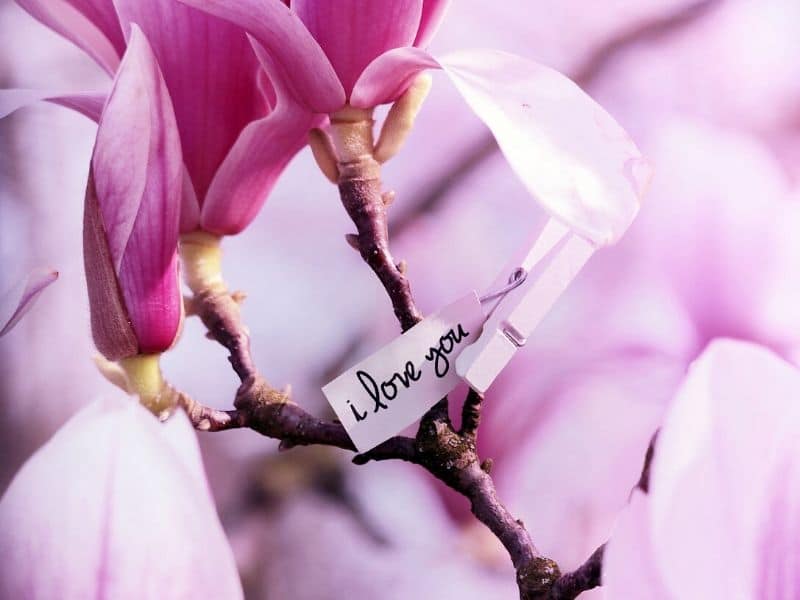
What are good companion plants with Magnolias?
This depends on whether you have an evergreen variety or deciduous variety. For example, if you have evergreen variety then you need to plant something that will be okay with being underneath a deep shade.
On the other hand, if you have a deciduous variety, then you need to plant something that will tolerate crispy leaves that will, eventually, fall from your tree.
Why are magnolia leaves turning yellow?
Magnolia leaves may turn yellow due to factors like nutrient deficiency, improper watering, soil pH imbalance, environmental stress, or pest issues. Addressing these factors, such as providing proper nutrients, maintaining consistent moisture, and checking for pests, can help remedy the yellowing leaves.
Conclusion
Planting magnolias is a relatively easy and excellent way to add value to your home.
Whether you live in a small area or a big farm, with Magnolias you have the opportunity to help them grow and reach your desired height. This is another reason why they are great deciduous trees to have, as they will not disturb your home, in fact, quite the opposite will occur, as they will give your place an added value.
To learn more about different types of flowers, visit our page https://florgeous.com/types-of-flowers/.
Up Next: Magnolia Flower Meaning and Symbolism of All Colors
References
Reference List:
(3) https://plants.usda.gov/plantguide/pdf/pg_magr4.pdf
(4) Sjöman, Henrik & Hirons, Andrew & Bassuk, Nina. (2018). Magnolias as urban trees – a preliminary evaluation of drought tolerance in seven magnolia species. Arboricultural Journal. 1-10. 10.1080/03071375.2017.1415554. – source
(5) Hanyan Luo, Hongwei Wu, Xiankuo Yu, Xiao Zhang, Yaqi Lu, Jianwei Fan, Liying Tang, Zhuju Wang, A review of the phytochemistry and pharmacological activities of Magnoliae officinalis cortex, Journal of Ethnopharmacology, Volume 236, 2019, Pages 412-442, ISSN 0378-8741, – source
(6) Poivre, M., & Duez, P. (2017). Biological activity and toxicity of the Chinese herb Magnolia officinalis Rehder & E. Wilson (Houpo) and its constituents. Journal of Zhejiang University. Science. B, 18(3), 194–214. https://doi.org/10.1631/jzus.B1600299
(7) https://plants.usda.gov/plantguide/pdf/pg_magr4.pdf
Close
*Featured Photo by were-photography/depositphotos

